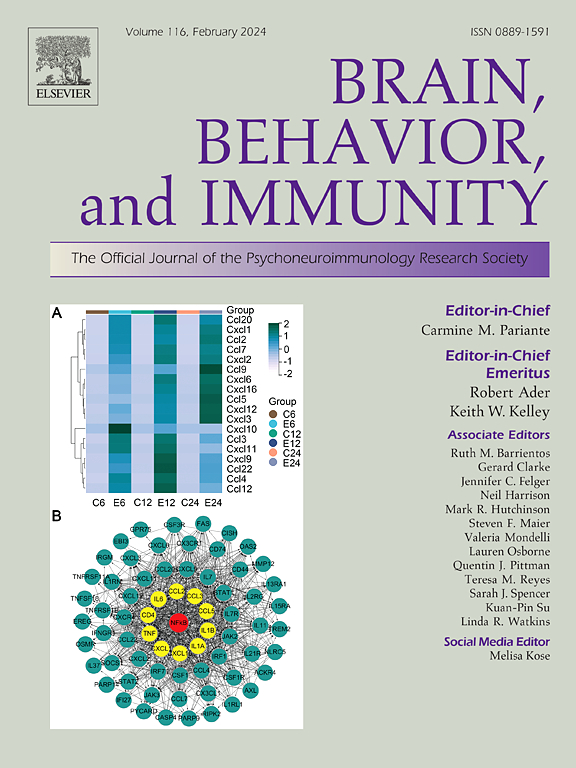Oleoylethanolamide-producing Lactobacillus paracasei F19 improves metabolic and behavioral disorders by restoring intestinal permeability and microbiota-gut-brain axis in high-fat diet-induced obese male mice
IF 8.8
2区 医学
Q1 IMMUNOLOGY
引用次数: 0
Abstract
Metabolic and mood disorders elicited by chronic exposure of high-fat diet (HFD) are often associated with intestinal dysbiosis and persistent low-grade inflammation in the small intestine. This leads to remodeling of the epithelial barrier with disruption of the neuroepithelial circuits that control energy homeostasis by the gut-brain axis. Therefore, therapies that restoreintestinal microbial niche and barrier function are promising candidates to counter peripheral metabolic challenges that affect behaviors controlled by the brain. The endogenous oleoylethanolamine (OEA) was found to shape the intestinal microbiota profile towards a “lean-like phenotype”, ameliorating pathological profiles of metabolic diseases. Further, OEA displays beneficial effects in several cognitive paradigms and preserves the epithelial barrier integrity, acting as an intestinal “gate-keeper”. Here, we developed an “intestinal OEA factory” for the in-situ and controlled release of OEA by using a probiotic-based delivery system. We engineered the Lactobacillus paracasei F19 (LP) to express the human N-acylphosphatidylethanolamine-preferring phospholipase D (NAPEpld) gene and to produce OEA in response to dietary ultra-low oleate supply. We treated 12-week HFD male mice with oleate-probiotic formulations and assessed their impact on metabolic and behavioral dysfunctions, and microbiota-gut-brain signaling after 8 weeks of treatment. NAPE-expressing LP (pNAPE-LP) led to significant reduced weight loss and improved metabolic dysfunction in HFD-treated mice. Further, a parallel improvement in depressive- and anxiety-like phenotypes was associated with the duodenal barrier function retrieval, the restoration of the Firmicutes/Bacteroidetes ratio, and an increase in beneficial bacteria, such as Lactobacillus, Prevotella, and Parabacteroides. The HFD-driven changes both in the enteric and central nervous system were prevented by pNAPE-LP/oleate treatment. Collectively, our data suggest that these effects were mediated by the oleate-dependent release of OEA by pNAPE-LP since no significant effects were observed in HFD mice treated with the native probiotic alone (pLP). This oleate-regulated delivery system of OEA is a safe and efficient probiotic-based strategy for the treatment of metabolic syndrome and related behavioral disorders.

长期摄入高脂肪饮食(HFD)引起的代谢紊乱和情绪失调往往与肠道菌群失调和小肠持续低度炎症有关。这导致上皮屏障重塑,并破坏了通过肠脑轴控制能量平衡的神经上皮回路。因此,恢复肠道微生物生态位和屏障功能的疗法有望应对影响大脑控制行为的外周代谢挑战。研究发现,内源性油酰乙醇胺(OEA)能将肠道微生物群谱塑造成 "类瘦表型",从而改善代谢性疾病的病理特征。此外,卵磷脂酰乙醇胺在多个认知范例中显示出有益作用,并能保护上皮屏障的完整性,起到肠道 "守门员 "的作用。在此,我们开发了一种 "肠道 OEA 工厂",利用基于益生菌的递送系统就地控制释放 OEA。我们设计了副卡氏乳杆菌 F19(LP)来表达人类 N-acylphosphatidylethanolamine-preferring phospholipase D(NAPEpld)基因,并在超低油酸饮食供应下产生 OEA。我们用油酸酯益生菌制剂处理了 12 周高密度脂蛋白膳食雄性小鼠,并在处理 8 周后评估了它们对代谢和行为功能障碍以及微生物群-肠-脑信号传导的影响。表达 NAPE 的 LP(pNAPE-LP)显著减少了高密度脂蛋白胆固醇(HFD)治疗小鼠的体重下降,并改善了代谢功能障碍。此外,抑郁和焦虑表型的改善还与十二指肠屏障功能恢复、固着菌/类杆菌比例恢复以及乳酸杆菌、普雷沃特氏菌和副乳等有益细菌的增加有关。pNAPE-LP/oleate 处理可防止高氟酸驱动的肠道和中枢神经系统的变化。总之,我们的数据表明,这些效应是由 pNAPE-LP 释放的油酸依赖性 OEA 介导的,因为在单独使用本地益生菌(pLP)处理 HFD 小鼠时未观察到明显的效应。这种由油酸调节的 OEA 释放系统是一种安全、高效的基于益生菌的代谢综合征及相关行为障碍治疗策略。
本文章由计算机程序翻译,如有差异,请以英文原文为准。
求助全文
约1分钟内获得全文
求助全文
来源期刊
CiteScore
29.60
自引率
2.00%
发文量
290
审稿时长
28 days
期刊介绍:
Established in 1987, Brain, Behavior, and Immunity proudly serves as the official journal of the Psychoneuroimmunology Research Society (PNIRS). This pioneering journal is dedicated to publishing peer-reviewed basic, experimental, and clinical studies that explore the intricate interactions among behavioral, neural, endocrine, and immune systems in both humans and animals.
As an international and interdisciplinary platform, Brain, Behavior, and Immunity focuses on original research spanning neuroscience, immunology, integrative physiology, behavioral biology, psychiatry, psychology, and clinical medicine. The journal is inclusive of research conducted at various levels, including molecular, cellular, social, and whole organism perspectives. With a commitment to efficiency, the journal facilitates online submission and review, ensuring timely publication of experimental results. Manuscripts typically undergo peer review and are returned to authors within 30 days of submission. It's worth noting that Brain, Behavior, and Immunity, published eight times a year, does not impose submission fees or page charges, fostering an open and accessible platform for scientific discourse.

 求助内容:
求助内容: 应助结果提醒方式:
应助结果提醒方式:


